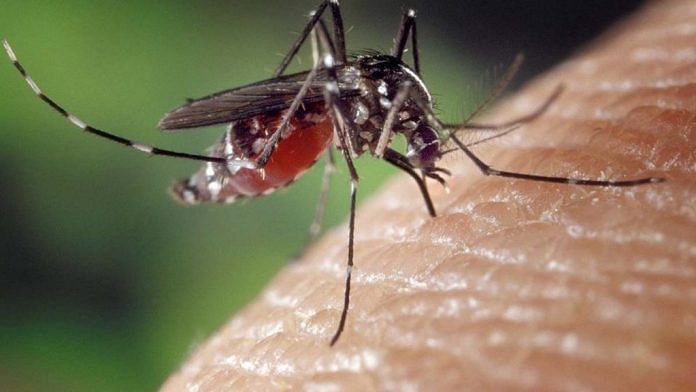Edinburgh: Mosquitoes in warm and sultry parts of the world have been agents of great misery for thousands of years, carrying within them microscopic parasites that are responsible for around 5 lakh deaths annually.
These parasites belong to the Plasmodium genus and cause malaria, a disease that is one of the leading causes of death in children aged below five years. Concerted efforts over the last decade have led to a decline in cases. However, progress appears to be stalling again.
This is particularly worrying for a country like India, which reportedly has the fourth highest incidence of malaria in the world.
Multiple factors contribute to this worrying trend. An important one is the emergence of drug resistance in the parasite, which renders the current line of antimalarials ineffective against the disease. Another is the development of insecticide resistance in mosquitoes.
Also Read: Malaria cases down in India by 51% in 2018 but it’s still among worst-hit countries
The role of mosquitoes
The parasite needs two hosts for its survival — humans and mosquitoes. While the multiplication of the parasite in human blood is responsible for the symptoms of the disease, the mosquito acts as a vehicle for transmission.
When a female Anopheles mosquito feeds on an infected person, she ingests the parasites from their blood and provides an ideal environment for their development into infective forms called sporozoites.
These are then stored in the salivary glands of the mosquito, poised to infect another human through her next blood meal.
Mosquitoes are, therefore, instrumental in spreading the disease. Their vital role in transmission was recognised early on, and insecticides have been used ever since to kill mosquitoes and break this vicious chain of transmission.
Over the last decade, 40 per cent of the decline in cases has been attributed to the ‘pyrethroid’ class of insecticides used on bed nets in endemic areas.
The idea behind this form of disease intervention is thought to be exactly what malaria-endemic countries need, as it’s simple and cost-effective.
Encouraging people to sleep under insecticide-treated bed nets — a kind of meshed curtain that can cover the bed from all sides, a common sight in Indian households — has shown to reduce the spread of the disease drastically.
This happens in two ways: While the nets offer protection against mosquitoes harbouring the parasite, exposure to the insecticide coating kills mosquitoes. With the carriers of the disease gone, the chances of it spreading in the community are diminished.
Also Read: Indians will be infected with malaria, cholera and flu as part of new vaccination trials
A cyclical battle
However, reports of insecticide resistance have emerged from 73 countries, including India, ringing alarm bells that the positive effects of the insecticide-treated bed nets might be wearing off.
This strategy appears to be following the same pattern witnessed with DDT in the 1950s.
The indiscriminate spraying of DDT at the time had led to a huge decline in malaria incidence, but, over the years, mosquitoes developed immunity.
By the 1970s, the profligate use of the insecticide had already caused rampant ecological damage, harming many birds, amphibians and fish.
And now, we know that certain mosquito strains no longer succumb to the insecticides currently used on bed nets.
Scientists have taken a closer look at the inner workings of the mosquito to identify mechanisms through which they are acquiring resistance. Most common among these is a certain detoxifying protein belonging to the ‘cytochrome P450’ class, which is present in mosquitoes and can break down the drug and clear it from the system. In humans, similar proteins detoxify artificial chemicals like drugs, food preservatives etc from the body. This, however, is not the only strategy used by the mosquitoes to fight insecticides.
Lab studies have also confirmed that some mosquitoes resistant to lethal insecticide produce higher amounts of a certain ‘chemosensory’ protein that enables them to sense different odours.
Experiments show that these proteins bind strongly to the insecticides, perhaps sequestering them and shielding the insect against their toxic effects.
By understanding why mosquitoes do not respond to the current line of insecticides, new strategies can be devised to target the problem of resistance.
CytochromeP450-mediated resistance is already being tackled by the development of a new compound, which, when given in combination with insecticides, counters resistance. These studies are relevant for sub-Saharan Africa and India, which account for 85 per cent of the global malaria burden.
Irrespective of resistance, the use of bed nets still offers a degree of protection to individuals, and is therefore strongly recommended in endemic areas by the World Health Organisation. Nonetheless, it is worrying that the beneficial community-effect of these insecticides might be eroding.
The findings of these studies are important in helping devise new strategies and solutions — millions of lives are at stake.
Neelakshi Varma is a science writer and a research student working on malaria at the School of Biological Sciences in University of Edinburgh.
Also Read: Malaria drug hydroxychloroquine no better than regular coronavirus care, Chinese study says






